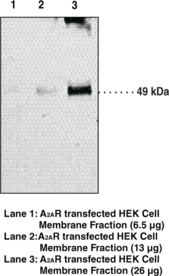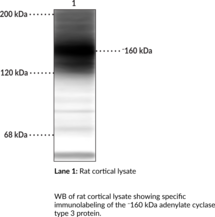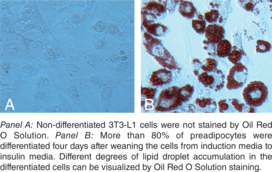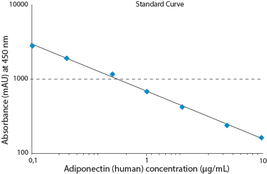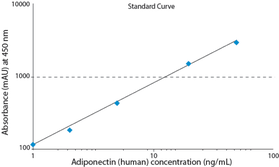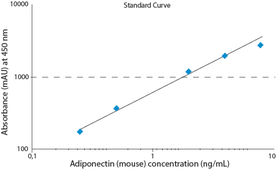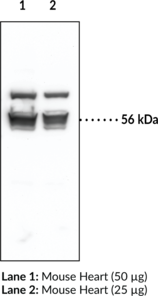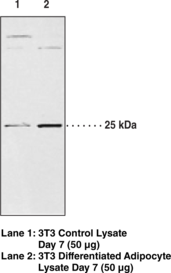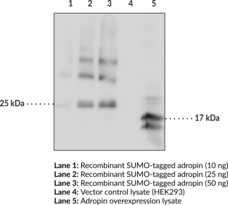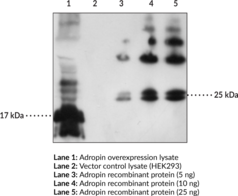Cayman
Showing 8551–8700 of 45550 results
-
Adenosine 5’-phosphosulfate is an ATP and sulfate competitive inhibitor of ATP sulfurylase in humans, S. cerevisiae, and P. chrysogenum (Ki = 18, 2500, and 1500 nM, respectively).{34578,34580} Adenosine 5′-phosphosulfate also inhibits human adenosine 5′-phosphosulfate kinase (Ki = 47.5 μM) to prevent sulfation.{34580,34579}
Brand:CaymanSKU:21226 -Out of stock
Adenosine 5’-phosphosulfate is an ATP and sulfate competitive inhibitor of ATP sulfurylase in humans, S. cerevisiae, and P. chrysogenum (Ki = 18, 2500, and 1500 nM, respectively).{34578,34580} Adenosine 5′-phosphosulfate also inhibits human adenosine 5′-phosphosulfate kinase (Ki = 47.5 μM) to prevent sulfation.{34580,34579}
Brand:CaymanSKU:21226 -Out of stock
Adenosine 5’-phosphosulfate is an ATP and sulfate competitive inhibitor of ATP sulfurylase in humans, S. cerevisiae, and P. chrysogenum (Ki = 18, 2500, and 1500 nM, respectively).{34578,34580} Adenosine 5′-phosphosulfate also inhibits human adenosine 5′-phosphosulfate kinase (Ki = 47.5 μM) to prevent sulfation.{34580,34579}
Brand:CaymanSKU:21226 -Out of stock
Adenosine 5’-phosphosulfate is an ATP and sulfate competitive inhibitor of ATP sulfurylase in humans, S. cerevisiae, and P. chrysogenum (Ki = 18, 2500, and 1500 nM, respectively).{34578,34580} Adenosine 5′-phosphosulfate also inhibits human adenosine 5′-phosphosulfate kinase (Ki = 47.5 μM) to prevent sulfation.{34580,34579}
Brand:CaymanSKU:21226 -Out of stock
Adenosine 5′-triphosphate (ATP) is a central component of energy storage and metabolism in vivo, providing the metabolic energy to drive metabolic pumps and serving as a coenzyme in a wide array of enzymatic reactions.{22973} ATP is a substrate for kinases involved in cell signaling and of adenylate cyclases that produce the second messenger cAMP.{22973} It is utilized in various cellular processes including, respiration, biosynthetic reactions, motility, and cell division.
Brand:CaymanSKU:-Adenosine 5′-triphosphate (ATP) is a central component of energy storage and metabolism in vivo, providing the metabolic energy to drive metabolic pumps and serving as a coenzyme in a wide array of enzymatic reactions.{22973} ATP is a substrate for kinases involved in cell signaling and of adenylate cyclases that produce the second messenger cAMP.{22973} It is utilized in various cellular processes including, respiration, biosynthetic reactions, motility, and cell division.
Brand:CaymanSKU:-Adenosine 5′-triphosphate (ATP) is a central component of energy storage and metabolism in vivo, providing the metabolic energy to drive metabolic pumps and serving as a coenzyme in a wide array of enzymatic reactions.{22973} ATP is a substrate for kinases involved in cell signaling and of adenylate cyclases that produce the second messenger cAMP.{22973} It is utilized in various cellular processes including, respiration, biosynthetic reactions, motility, and cell division.
Brand:CaymanSKU:-Adenosine 5′-triphosphate (ATP) is a central component of energy storage and metabolism in vivo, providing the metabolic energy to drive metabolic pumps and serving as a coenzyme in a wide array of enzymatic reactions.{22973} ATP is a substrate for kinases involved in cell signaling and of adenylate cyclases that produce the second messenger cAMP.{22973} It is utilized in various cellular processes including, respiration, biosynthetic reactions, motility, and cell division.
Brand:CaymanSKU:-Adenosine dialdehyde is an irreversible inhibitor of S-adenosylhomocysteine (SAH; Item Nos. 13603 | 9000372) hydrolase (IC50 = 40 nM), blocking the conversion of SAH to homocysteine and adenosine (Item No. 21232).{33757,33759} This reduces the amount of homocysteine that can be converted to methionine and, subsequently, S-adenosylmethionine, a substrate of methyltransferases. In this way, adenosine dialdehyde indirectly inhibits cellular methyltransferase activity.{33752,33756,33758}
Brand:CaymanSKU:-Adenosine dialdehyde is an irreversible inhibitor of S-adenosylhomocysteine (SAH; Item Nos. 13603 | 9000372) hydrolase (IC50 = 40 nM), blocking the conversion of SAH to homocysteine and adenosine (Item No. 21232).{33757,33759} This reduces the amount of homocysteine that can be converted to methionine and, subsequently, S-adenosylmethionine, a substrate of methyltransferases. In this way, adenosine dialdehyde indirectly inhibits cellular methyltransferase activity.{33752,33756,33758}
Brand:CaymanSKU:-Adenosine dialdehyde is an irreversible inhibitor of S-adenosylhomocysteine (SAH; Item Nos. 13603 | 9000372) hydrolase (IC50 = 40 nM), blocking the conversion of SAH to homocysteine and adenosine (Item No. 21232).{33757,33759} This reduces the amount of homocysteine that can be converted to methionine and, subsequently, S-adenosylmethionine, a substrate of methyltransferases. In this way, adenosine dialdehyde indirectly inhibits cellular methyltransferase activity.{33752,33756,33758}
Brand:CaymanSKU:-Adenosine dialdehyde is an irreversible inhibitor of S-adenosylhomocysteine (SAH; Item Nos. 13603 | 9000372) hydrolase (IC50 = 40 nM), blocking the conversion of SAH to homocysteine and adenosine (Item No. 21232).{33757,33759} This reduces the amount of homocysteine that can be converted to methionine and, subsequently, S-adenosylmethionine, a substrate of methyltransferases. In this way, adenosine dialdehyde indirectly inhibits cellular methyltransferase activity.{33752,33756,33758}
Brand:CaymanSKU:-Antigen: human full length A2AR; the antibody recognizes amino acids 213-220 as determined by epitope mapping • Host: mouse, clone 7FG-G5-A2 • Cross Reactivity: (+) human A2AR • Application(s): WB • A2AR is a multi-pass membrane protein found primarily in the brain striatum, but also in immune cells and other tissues and may play a role in the treatment of Parkinson’s disease
Brand:CaymanSKU:10011454- 1 eaAdenosine receptor A2A Monoclonal Antibody (A2AR) is a multi-pass membrane protein that is normally localized to the plasma membrane.{15465} This receptor is part of the G protein-coupled receptor family that binds adenosine and serves multiple functions. Antagonists of this receptor have been targeted for the treatment of Parkinson’s disease.{15466,5049} Early reports found this receptor is found primarily in the brain striatum, but is also found in immune cells and other tissues as well.{15466} A2AR is comprised of 412 amino acids with an expected molecular weight of 45 kDa.{16148,15465} However multiple glycosylation sites exist that may explain the retarded migration observed by western blotting (45-50 kDa).{15465} This antibody has been extensively characterized and the epitope has been mapped to the third intracellular loop of the receptor.{16545}
Brand:CaymanSKU:10011454 - 1 eaAvailable on backorder
Antigen: human full length A2AR; the antibody recognizes amino acids 213-220 as determined by epitope mapping • Host: mouse, clone 7FG-G5-A2 • Cross Reactivity: (+) human A2AR • Application(s): WB • A2AR is a multi-pass membrane protein found primarily in the brain striatum, but also in immune cells and other tissues and may play a role in the treatment of Parkinson’s disease
Brand:CaymanSKU:10011454- 1 eaAvailable on backorder
Adenylate cyclase type 3 (AC3) is a membrane-bound protein that catalyzes the formation of the second messenger cAMP from ATP (Item No. 14498) in response to G protein-coupled receptor (GPCR) signaling.{55136,55137} It consists of 1,144 amino acids and is comprised of a cytoplasmic N-terminus followed by two repeating modules, each consisting of a transmembrane domain and a cytoplasmic domain, with the transmembrane domains composed of six membrane-spanning helices apiece.{55135,55136} ADCY3, the gene encoding AC3, is expressed in a variety of tissues, with high levels in the placenta, testes, ovaries, and colon in humans.{55136,55135} AC3 also localizes to primary cilia in the brain and has been used as a marker of primary cilia in mouse brain.{55138,55139} Mutations in ADCY3 are associated with an increased risk of obesity and type 2 diabetes.{55137,55135,55138} Cayman’s Adenylate Cyclase Type 3 Polyclonal Antibody can be used for immunocytochemistry (ICC), immunohistochemistry (IHC), and Western blot (WB) applications. The antibody recognizes AC3 at approximately 160 kDa from human, mouse, and rat samples.
Brand:CaymanSKU:29250 - 100 µlAvailable on backorder
Immunogen: Synthetic peptide from the C-terminal region of rat adenylate cyclase type 3 conjugated to KLH • Host: Rabbit • Species Reactivity: (+) Human, Mouse, Rat • Applications: ICC, IHC, WB • MW = ~160 kDa
Brand:CaymanSKU:29250- 100 µlAvailable on backorder
Immunogen: Synthetic peptide from the C-terminal region of rat adenylate cyclase type 3 conjugated to KLH • Host: Rabbit • Species Reactivity: (+) Human, Mouse, Rat • Applications: ICC, IHC, WB • MW = ~160 kDa
Brand:CaymanSKU:29250- 100 µlAdenylosuccinic acid is a purine nucleotide and an intermediate in the purine nucleotide cycle.{52338} It is converted into AMP and fumarate by adenylosuccinate lyase in the cytosol. Adenylosuccinic acid (10 µM) inhibits calcium-induced activation of non-selective cation channels in isolated rat brown adipocytes in a patch-clamp assay.{52339} Adenylosuccinic acid (10 µM) increases glucose-induced insulin exocytosis in 832/13 INS-1 pancreatic β-cells.{52340} It induces contractions in isolated guinea pig uterus strips when used at a concentration of 100 µM.{52341}
Brand:CaymanSKU:29696 - 10 mgAvailable on backorder
Adenylosuccinic acid is a purine nucleotide and an intermediate in the purine nucleotide cycle.{52338} It is converted into AMP and fumarate by adenylosuccinate lyase in the cytosol. Adenylosuccinic acid (10 µM) inhibits calcium-induced activation of non-selective cation channels in isolated rat brown adipocytes in a patch-clamp assay.{52339} Adenylosuccinic acid (10 µM) increases glucose-induced insulin exocytosis in 832/13 INS-1 pancreatic β-cells.{52340} It induces contractions in isolated guinea pig uterus strips when used at a concentration of 100 µM.{52341}
Brand:CaymanSKU:29696 - 100 mgAvailable on backorder
Adenylosuccinic acid is a purine nucleotide and an intermediate in the purine nucleotide cycle.{52338} It is converted into AMP and fumarate by adenylosuccinate lyase in the cytosol. Adenylosuccinic acid (10 µM) inhibits calcium-induced activation of non-selective cation channels in isolated rat brown adipocytes in a patch-clamp assay.{52339} Adenylosuccinic acid (10 µM) increases glucose-induced insulin exocytosis in 832/13 INS-1 pancreatic β-cells.{52340} It induces contractions in isolated guinea pig uterus strips when used at a concentration of 100 µM.{52341}
Brand:CaymanSKU:29696 - 25 mgAvailable on backorder
Adenylosuccinic acid is a purine nucleotide and an intermediate in the purine nucleotide cycle.{52338} It is converted into AMP and fumarate by adenylosuccinate lyase in the cytosol. Adenylosuccinic acid (10 µM) inhibits calcium-induced activation of non-selective cation channels in isolated rat brown adipocytes in a patch-clamp assay.{52339} Adenylosuccinic acid (10 µM) increases glucose-induced insulin exocytosis in 832/13 INS-1 pancreatic β-cells.{52340} It induces contractions in isolated guinea pig uterus strips when used at a concentration of 100 µM.{52341}
Brand:CaymanSKU:29696 - 50 mgAvailable on backorder
ADH-1 is a cyclic peptide antagonist of N-cadherin. {46719} It inhibits neurite outgrowth in cerebellar neurons cultured on N-cadherin-expressing 3T3 cell monolayers (IC50 = 0.323 mM). ADH-1 (0.2 mg/ml) inhibits cell scattering and motility induced by collagen I in Capan-1 cells and wild-type and N-cadherin-overexpressing BxPC-3 cells.{46720} It induces apoptosis in N-cadherin-overexpressing, but not knockdown, BxPC-3 cells when used at a concentration of 1 mg/ml. ADH-1 (50 mg/kg) reduces tumor growth in an N-cadherin-overexpressing BxPC-3 mouse xenograft model.
Brand:CaymanSKU:29981 - 1 mgAvailable on backorder
ADH-1 is a cyclic peptide antagonist of N-cadherin. {46719} It inhibits neurite outgrowth in cerebellar neurons cultured on N-cadherin-expressing 3T3 cell monolayers (IC50 = 0.323 mM). ADH-1 (0.2 mg/ml) inhibits cell scattering and motility induced by collagen I in Capan-1 cells and wild-type and N-cadherin-overexpressing BxPC-3 cells.{46720} It induces apoptosis in N-cadherin-overexpressing, but not knockdown, BxPC-3 cells when used at a concentration of 1 mg/ml. ADH-1 (50 mg/kg) reduces tumor growth in an N-cadherin-overexpressing BxPC-3 mouse xenograft model.
Brand:CaymanSKU:29981 - 10 mgAvailable on backorder
ADH-1 is a cyclic peptide antagonist of N-cadherin. {46719} It inhibits neurite outgrowth in cerebellar neurons cultured on N-cadherin-expressing 3T3 cell monolayers (IC50 = 0.323 mM). ADH-1 (0.2 mg/ml) inhibits cell scattering and motility induced by collagen I in Capan-1 cells and wild-type and N-cadherin-overexpressing BxPC-3 cells.{46720} It induces apoptosis in N-cadherin-overexpressing, but not knockdown, BxPC-3 cells when used at a concentration of 1 mg/ml. ADH-1 (50 mg/kg) reduces tumor growth in an N-cadherin-overexpressing BxPC-3 mouse xenograft model.
Brand:CaymanSKU:29981 - 25 mgAvailable on backorder
ADH-1 is a cyclic peptide antagonist of N-cadherin. {46719} It inhibits neurite outgrowth in cerebellar neurons cultured on N-cadherin-expressing 3T3 cell monolayers (IC50 = 0.323 mM). ADH-1 (0.2 mg/ml) inhibits cell scattering and motility induced by collagen I in Capan-1 cells and wild-type and N-cadherin-overexpressing BxPC-3 cells.{46720} It induces apoptosis in N-cadherin-overexpressing, but not knockdown, BxPC-3 cells when used at a concentration of 1 mg/ml. ADH-1 (50 mg/kg) reduces tumor growth in an N-cadherin-overexpressing BxPC-3 mouse xenograft model.
Brand:CaymanSKU:29981 - 5 mgAvailable on backorder
Brand:CaymanSKU:700002 - 150 µgAvailable on backorder
Adiphenine is an anticholinergic agent.{52813,52814,52815,52816} It is an antagonist of nicotinic acetylcholine receptors (nAChRs; IC50s = 1.8, 3.7, and 6.3 µM for the α3β4, α4β2, and α4β4 subunit-containing receptors, respectively), as well as muscarinic acetylcholine receptors (Ki = 0.44 µM).{52813,52814} Adiphenine inhibits contractions induced by acetylcholine (ACh) in isolated guinea pig ileum in a concentration-dependent manner.{52814} It prevents tonic hindlimb extension in a mouse model of seizures induced by maximal electroshock (MES) with an ED50 value of 62 mg/kg but is neurotoxic at higher doses.{52815} Adiphenine protects against organophosphate-induced lethality in mice with a 50% protective dose (PD50) value of 3.3 mg/kg.{52816} It has also been used as a local anesthetic.{52813,52815}
Brand:CaymanSKU:31124 - 10 gAvailable on backorder
Adiphenine is an anticholinergic agent.{52813,52814,52815,52816} It is an antagonist of nicotinic acetylcholine receptors (nAChRs; IC50s = 1.8, 3.7, and 6.3 µM for the α3β4, α4β2, and α4β4 subunit-containing receptors, respectively), as well as muscarinic acetylcholine receptors (Ki = 0.44 µM).{52813,52814} Adiphenine inhibits contractions induced by acetylcholine (ACh) in isolated guinea pig ileum in a concentration-dependent manner.{52814} It prevents tonic hindlimb extension in a mouse model of seizures induced by maximal electroshock (MES) with an ED50 value of 62 mg/kg but is neurotoxic at higher doses.{52815} Adiphenine protects against organophosphate-induced lethality in mice with a 50% protective dose (PD50) value of 3.3 mg/kg.{52816} It has also been used as a local anesthetic.{52813,52815}
Brand:CaymanSKU:31124 - 100 gAvailable on backorder
Adiphenine is an anticholinergic agent.{52813,52814,52815,52816} It is an antagonist of nicotinic acetylcholine receptors (nAChRs; IC50s = 1.8, 3.7, and 6.3 µM for the α3β4, α4β2, and α4β4 subunit-containing receptors, respectively), as well as muscarinic acetylcholine receptors (Ki = 0.44 µM).{52813,52814} Adiphenine inhibits contractions induced by acetylcholine (ACh) in isolated guinea pig ileum in a concentration-dependent manner.{52814} It prevents tonic hindlimb extension in a mouse model of seizures induced by maximal electroshock (MES) with an ED50 value of 62 mg/kg but is neurotoxic at higher doses.{52815} Adiphenine protects against organophosphate-induced lethality in mice with a 50% protective dose (PD50) value of 3.3 mg/kg.{52816} It has also been used as a local anesthetic.{52813,52815}
Brand:CaymanSKU:31124 - 25 gAvailable on backorder
Adiphenine is an anticholinergic agent.{52813,52814,52815,52816} It is an antagonist of nicotinic acetylcholine receptors (nAChRs; IC50s = 1.8, 3.7, and 6.3 µM for the α3β4, α4β2, and α4β4 subunit-containing receptors, respectively), as well as muscarinic acetylcholine receptors (Ki = 0.44 µM).{52813,52814} Adiphenine inhibits contractions induced by acetylcholine (ACh) in isolated guinea pig ileum in a concentration-dependent manner.{52814} It prevents tonic hindlimb extension in a mouse model of seizures induced by maximal electroshock (MES) with an ED50 value of 62 mg/kg but is neurotoxic at higher doses.{52815} Adiphenine protects against organophosphate-induced lethality in mice with a 50% protective dose (PD50) value of 3.3 mg/kg.{52816} It has also been used as a local anesthetic.{52813,52815}
Brand:CaymanSKU:31124 - 50 gAvailable on backorder
Brand:CaymanSKU:10008980 - 1 eaAvailable on backorder
Obesity is a growing concern worldwide and has reached epidemic proportions in the United States.{10590} It is a risk factor in many major chronic diseases that afflict our society, including cardiovascular disease, diabetes mellitus, and cancer. In recent years, numerous studies have focused on identifying the mechanism of development of obesity, which is a process of either increasing the number of fat cells (fat cell hyperplasia) or enlargement of fat cells with each cell carrying greater amounts of fat (fat cell hypertrophy), or both.{6620,10590} The ability to regulate the cell cycle and differentiation of adipocytes are key in the development and physiology of obesity and also in the origin of cancer. Understanding of these processes is critical to a rational approach to the treatment of obesity and cancer. Cayman’s Adipogenesis Assay Kit provides the reagents required for studying the induction and inhibition of adipogenesis in the established 3T3-L1 model, using the adipogenesis induction procedure. This kit can also be used to screen drug candidates involved in adipogenesis. The classic Oil Red O staining for lipid droplets is used in this kit as an indicator of the degree of adipogenesis, and can be quantified with a plate reader after the dye is conveniently extracted from the lipid droplet.
Brand:CaymanSKU:10006908 - 1 eaAvailable on backorder
Brand:CaymanSKU:10009950 - 1 eaAvailable on backorder
Brand:CaymanSKU:10009948 - 1 eaAvailable on backorder
Brand:CaymanSKU:10009951 - 1 eaAvailable on backorder
Cayman’s Adipolysis Assay Kit provides a complete assay for studying the lipolysis of triglycerides, from the differentiation of adipocyte-like cells to the quantitation of released glycerol. 3T3-L1 cells are differentiated using a common adipogenesis induction procedure to accumulate lipid droplets, and isoproterenol is included as a positive control for release of glycerol from triglycerides. Free glycerol in the cell culture medium is measured by incubation with glycerol kinase, glycerol phosphate oxidase, and horseradish peroxidase in the presence of a colorimetric substrate to generate a chromophore detectable at 540 nm. The amount of glycerol release is correlated with both the amount of stored triglyceride and the degree of lipolysis, making this kit useful for investigators screening compounds affecting either lipid storage or metabolism. The Adipolysis Assay Kit provides enough reagents to assay one 96-well plate of supernatants for glycerol release. The accumulation of lipid droplets can be alternatively assayed with either the Lipid Droplets Fluorescence Assay Kit (Item No. 500001) or the Adipogenesis Assay Kit (Item No. 10006908), and glycerol release alone can be assayed using the Glycerol Cell-Based Assay Kit (Item No. 10011725).
Brand:CaymanSKU:10009381 - 1 eaAvailable on backorder
Adiponectin, also known as Acpr30 and GPB-28, is a physiologically active protein which is specifically and highly expressed from adipose cells. Adipose tissue-expressed levels of adiponectin are inversely related to the degree of obesity and are correlated with insulin resistant states such as those found in obesity and type II diabetes mellitus. This Enzyme Linked Immunosorbent Assay (ELISA) is based on the competition between free adiponectin and coated adiponectin in the presence of a fixed quantity of HRP-labeled adiponectin antibody. [Bertin Catalog No. A05185]
Brand:CaymanSKU:500641 - 96 wellsAvailable on backorder
Adiponectin, also known as Acpr30 and GPB-28, is a physiologically active protein which is specifically and highly expressed from adipose cells. Adipose tissue-expressed levels of adiponectin are inversely related to the degree of obesity and are correlated with insulin resistance states such as those found in obesity and type II diabetes mellitus. Adiponectin increases insulin sensitivity and decreases plasma glucose by increasing fat oxidation. This Enzyme Immunometric Assay (EIA) is based on a double antibody sandwich technique that is applicable to the quantification of both low molecular weight and high molecular weight polymers of adiponectin, but not adiponectin trimers. [Bertin Catalog No. A05186]
Brand:CaymanSKU:10007619 - 96 wellsAvailable on backorder
Adiponectin, (Acrp30, AdipoQ, GBP-28), is a 244 amino acid protein specifically and highly expressed by adipose cells. Expression of adiponectin is inversely related to the degree of adiposity in which a reduction in serum adiponectin levels are accompanied by an increase in insulin resistance states, such as obesity and type II diabetes mellitus. Adiponectin increases insulin sensitivity and decreases plasma glucose by increasing tissue fat oxidation. This Enzyme Immunometric Assay (EIA) is based on a double-antibody sandwich technique which utilizes a mouse adiponectin-specific monoclonal capture antibody and a HRP-conjugated polyclonal antibody for detection. [Bertin Catalog No. A05187]
Brand:CaymanSKU:10007620 - 96 wellsAvailable on backorder
Adiponectin expressed by adipocytes exerts antidiabetic effects by binding to adiponectin receptor (AdipoR)1, which activates AMPK pathways, and AdipoR2, which activates PPARα pathways. AdipoRon is an orally active small molecule AdipoR agonist that binds AdipoR1 and AdipoR2 with KD values of 1.8 and 3.1 µM, respectively.{25721} At 50 mg/kg, it acts similarly to adiponectin, activating AMPK and PPARα pathways and reducing insulin resistance and glucose intolerance in wild type mice fed a high-fat diet and in genetically obese db/db mice.{25721}
Brand:CaymanSKU:-Adiponectin expressed by adipocytes exerts antidiabetic effects by binding to adiponectin receptor (AdipoR)1, which activates AMPK pathways, and AdipoR2, which activates PPARα pathways. AdipoRon is an orally active small molecule AdipoR agonist that binds AdipoR1 and AdipoR2 with KD values of 1.8 and 3.1 µM, respectively.{25721} At 50 mg/kg, it acts similarly to adiponectin, activating AMPK and PPARα pathways and reducing insulin resistance and glucose intolerance in wild type mice fed a high-fat diet and in genetically obese db/db mice.{25721}
Brand:CaymanSKU:-Adiponectin expressed by adipocytes exerts antidiabetic effects by binding to adiponectin receptor (AdipoR)1, which activates AMPK pathways, and AdipoR2, which activates PPARα pathways. AdipoRon is an orally active small molecule AdipoR agonist that binds AdipoR1 and AdipoR2 with KD values of 1.8 and 3.1 µM, respectively.{25721} At 50 mg/kg, it acts similarly to adiponectin, activating AMPK and PPARα pathways and reducing insulin resistance and glucose intolerance in wild type mice fed a high-fat diet and in genetically obese db/db mice.{25721}
Brand:CaymanSKU:-Adiponectin expressed by adipocytes exerts antidiabetic effects by binding to adiponectin receptor (AdipoR)1, which activates AMPK pathways, and AdipoR2, which activates PPARα pathways. AdipoRon is an orally active small molecule AdipoR agonist that binds AdipoR1 and AdipoR2 with KD values of 1.8 and 3.1 µM, respectively.{25721} At 50 mg/kg, it acts similarly to adiponectin, activating AMPK and PPARα pathways and reducing insulin resistance and glucose intolerance in wild type mice fed a high-fat diet and in genetically obese db/db mice.{25721}
Brand:CaymanSKU:-Immunogen: Synthetic peptide from an internal region of human ATGL • Host: Rabbit • Species Reactivity: (+) Human, mouse, and rat • Applications: IHC (paraffin-embedded tissue) and WB
Brand:CaymanSKU:10006409- 1 eaAvailable on backorder
Immunogen: Synthetic peptide from an internal region of human ATGL • Host: Rabbit • Species Reactivity: (+) Human, mouse, and rat • Applications: IHC (paraffin-embedded tissue) and WB
Brand:CaymanSKU:10006409- 1 eaTriglycerides are the most efficient form of energy storage in mammalian adipose tissue during times of caloric excess. ATGL is one of the key enzymes involved in the mobilization of fatty acids from triglyceride stores in adipose tissue, catalyzing the conversion of triacylglycerols to diacylglycerols.{12373} Inhibition of ATGL markedly decreases total adipose acyl-hydrolase activity, and thus may be a potential drug target for the diabetic pathology.{12373} ATGL mRNA is detected in a wide range of tissues including adipose, lung, skeletal muscle, testis, heart, brain, and kidney, with adipose tissue expressing the highest level.{13488} Human ATGL is 504 amino acids in length with an estimated molecular weight of 55.2 kDa. Cayman’s ATGL Polyclonal Antibody detects the enzyme at 56 kDa by Western blot from tissues and cells such as brown fat, liver, mouse macrophages, and HepG2 cells.
Brand:CaymanSKU:10006409 - 1 eaAvailable on backorder
Adipostatin A is an inhibitor of glycerol-3-phosphate dehydrogenase (GPDH; IC50 = 4.1 µM).{34617} It prevents triglyceride accumulation in 3T3-L1 cells when applied at 5-7.5 µM.{34617} Adipostatin A is cytotoxic against fibroblast carcinoma KB cell lines with an IC50 value of 10.6 µM.{34618} It also shows larvicidal activity (LC90 = 10.22 ppm) against A. aegypti.{34619}
Brand:CaymanSKU:22163 -Out of stock
Adipostatin A is an inhibitor of glycerol-3-phosphate dehydrogenase (GPDH; IC50 = 4.1 µM).{34617} It prevents triglyceride accumulation in 3T3-L1 cells when applied at 5-7.5 µM.{34617} Adipostatin A is cytotoxic against fibroblast carcinoma KB cell lines with an IC50 value of 10.6 µM.{34618} It also shows larvicidal activity (LC90 = 10.22 ppm) against A. aegypti.{34619}
Brand:CaymanSKU:22163 -Out of stock
Adjudin is a derivative of ionidamine that inhibits human spermatozoa capacitance, potentially by blocking chloride channels.{40350} It inhibits spermatozoa hyperactivated motility and the acrosome reaction and prevents sperm-egg fusion in zona-free hamster eggs. It also disrupts Sertoli-germ cell junctions by increasing tight junction and basal ectoplasmic specialization protein levels, which tightens the cell permeability barrier dose-dependently in vitro.{40351} Adjudin (25 and 50 mg/kg) increases testin expression in adult rat testes within one day and depletes spermatids and spermatocytes within 14 days.{40349} Under various dosing parameters, adjudin reversibly induces infertility of male rats within 3-7 weeks, which lasts 4-14 weeks, without affecting serum levels of luteinizing hormone (LH), follicle stimulating hormone (FSH), or testosterone. Adjudin also decreases proliferation of SGC-7901, MDA-MB-231, Smmc-7721, and MIA Paca-2 cells (IC50s = 58, 13.8, 72.3, and 52.7 µM, respectively) and induces apoptosis via the caspase-3-dependent pathway.{40352}
Brand:CaymanSKU:22939 - 1 mgAvailable on backorder
Adjudin is a derivative of ionidamine that inhibits human spermatozoa capacitance, potentially by blocking chloride channels.{40350} It inhibits spermatozoa hyperactivated motility and the acrosome reaction and prevents sperm-egg fusion in zona-free hamster eggs. It also disrupts Sertoli-germ cell junctions by increasing tight junction and basal ectoplasmic specialization protein levels, which tightens the cell permeability barrier dose-dependently in vitro.{40351} Adjudin (25 and 50 mg/kg) increases testin expression in adult rat testes within one day and depletes spermatids and spermatocytes within 14 days.{40349} Under various dosing parameters, adjudin reversibly induces infertility of male rats within 3-7 weeks, which lasts 4-14 weeks, without affecting serum levels of luteinizing hormone (LH), follicle stimulating hormone (FSH), or testosterone. Adjudin also decreases proliferation of SGC-7901, MDA-MB-231, Smmc-7721, and MIA Paca-2 cells (IC50s = 58, 13.8, 72.3, and 52.7 µM, respectively) and induces apoptosis via the caspase-3-dependent pathway.{40352}
Brand:CaymanSKU:22939 - 10 mgAvailable on backorder
Adjudin is a derivative of ionidamine that inhibits human spermatozoa capacitance, potentially by blocking chloride channels.{40350} It inhibits spermatozoa hyperactivated motility and the acrosome reaction and prevents sperm-egg fusion in zona-free hamster eggs. It also disrupts Sertoli-germ cell junctions by increasing tight junction and basal ectoplasmic specialization protein levels, which tightens the cell permeability barrier dose-dependently in vitro.{40351} Adjudin (25 and 50 mg/kg) increases testin expression in adult rat testes within one day and depletes spermatids and spermatocytes within 14 days.{40349} Under various dosing parameters, adjudin reversibly induces infertility of male rats within 3-7 weeks, which lasts 4-14 weeks, without affecting serum levels of luteinizing hormone (LH), follicle stimulating hormone (FSH), or testosterone. Adjudin also decreases proliferation of SGC-7901, MDA-MB-231, Smmc-7721, and MIA Paca-2 cells (IC50s = 58, 13.8, 72.3, and 52.7 µM, respectively) and induces apoptosis via the caspase-3-dependent pathway.{40352}
Brand:CaymanSKU:22939 - 25 mgAvailable on backorder
Adjudin is a derivative of ionidamine that inhibits human spermatozoa capacitance, potentially by blocking chloride channels.{40350} It inhibits spermatozoa hyperactivated motility and the acrosome reaction and prevents sperm-egg fusion in zona-free hamster eggs. It also disrupts Sertoli-germ cell junctions by increasing tight junction and basal ectoplasmic specialization protein levels, which tightens the cell permeability barrier dose-dependently in vitro.{40351} Adjudin (25 and 50 mg/kg) increases testin expression in adult rat testes within one day and depletes spermatids and spermatocytes within 14 days.{40349} Under various dosing parameters, adjudin reversibly induces infertility of male rats within 3-7 weeks, which lasts 4-14 weeks, without affecting serum levels of luteinizing hormone (LH), follicle stimulating hormone (FSH), or testosterone. Adjudin also decreases proliferation of SGC-7901, MDA-MB-231, Smmc-7721, and MIA Paca-2 cells (IC50s = 58, 13.8, 72.3, and 52.7 µM, respectively) and induces apoptosis via the caspase-3-dependent pathway.{40352}
Brand:CaymanSKU:22939 - 5 mgAvailable on backorder
ADL5859 is a δ-opioid receptor agonist (Ki = 0.84 nM).{45386} It is selective for δ-opioid receptors over μ-opioid and κ-opioid receptors exhibiting 32 and 37% inhibition, respectively, in radioligand binding assays when used at a concentration of 10 μM. ADL5859 (3 mg/kg) completely reverses mechanical hyperalgesia induced by complete Freund’s adjuvant (CFA) in rats. It also decreases immobility time in the forced swim test in rats, indicating antidepressant-like activity.
Brand:CaymanSKU:27796 - 10 mgAvailable on backorder
ADL5859 is a δ-opioid receptor agonist (Ki = 0.84 nM).{45386} It is selective for δ-opioid receptors over μ-opioid and κ-opioid receptors exhibiting 32 and 37% inhibition, respectively, in radioligand binding assays when used at a concentration of 10 μM. ADL5859 (3 mg/kg) completely reverses mechanical hyperalgesia induced by complete Freund’s adjuvant (CFA) in rats. It also decreases immobility time in the forced swim test in rats, indicating antidepressant-like activity.
Brand:CaymanSKU:27796 - 25 mgAvailable on backorder
ADL5859 is a δ-opioid receptor agonist (Ki = 0.84 nM).{45386} It is selective for δ-opioid receptors over μ-opioid and κ-opioid receptors exhibiting 32 and 37% inhibition, respectively, in radioligand binding assays when used at a concentration of 10 μM. ADL5859 (3 mg/kg) completely reverses mechanical hyperalgesia induced by complete Freund’s adjuvant (CFA) in rats. It also decreases immobility time in the forced swim test in rats, indicating antidepressant-like activity.
Brand:CaymanSKU:27796 - 5 mgAvailable on backorder
ADL5859 is a δ-opioid receptor agonist (Ki = 0.84 nM).{45386} It is selective for δ-opioid receptors over μ-opioid and κ-opioid receptors exhibiting 32 and 37% inhibition, respectively, in radioligand binding assays when used at a concentration of 10 μM. ADL5859 (3 mg/kg) completely reverses mechanical hyperalgesia induced by complete Freund’s adjuvant (CFA) in rats. It also decreases immobility time in the forced swim test in rats, indicating antidepressant-like activity.
Brand:CaymanSKU:27796 - 50 mgAvailable on backorder
Adomeglivant is an allosteric antagonist of the glucagon receptor.{47796,47797} It inhibits glucagon-induced increases in cAMP levels in HEK293 cells expressing the rat glucagon or GLP-1 receptors (IC50s = 1.8 and 1.2 µM, respectively) but has no effect on cAMP levels when used alone.{47797} Adomeglivant also inhibits increases in cAMP levels induced by GLP-1 or exendin-4 (Item No. 11096) in HEK293 cells expressing the GLP-1 receptor (IC50s = 7 and 12 µM, respectively). It decreases glucose-stimulated insulin secretion when used at a concentration of 1 µM in combination with the GLP-1 receptor antagonist exendin (9-39) in isolated human islets but not glucose-stimulated glucagon secretion when used alone or in combination with exendin (9-39) in isolated mouse islets.{47798}
Brand:CaymanSKU:29668 - 1 mgAvailable on backorder
Adomeglivant is an allosteric antagonist of the glucagon receptor.{47796,47797} It inhibits glucagon-induced increases in cAMP levels in HEK293 cells expressing the rat glucagon or GLP-1 receptors (IC50s = 1.8 and 1.2 µM, respectively) but has no effect on cAMP levels when used alone.{47797} Adomeglivant also inhibits increases in cAMP levels induced by GLP-1 or exendin-4 (Item No. 11096) in HEK293 cells expressing the GLP-1 receptor (IC50s = 7 and 12 µM, respectively). It decreases glucose-stimulated insulin secretion when used at a concentration of 1 µM in combination with the GLP-1 receptor antagonist exendin (9-39) in isolated human islets but not glucose-stimulated glucagon secretion when used alone or in combination with exendin (9-39) in isolated mouse islets.{47798}
Brand:CaymanSKU:29668 - 10 mgAvailable on backorder
Adomeglivant is an allosteric antagonist of the glucagon receptor.{47796,47797} It inhibits glucagon-induced increases in cAMP levels in HEK293 cells expressing the rat glucagon or GLP-1 receptors (IC50s = 1.8 and 1.2 µM, respectively) but has no effect on cAMP levels when used alone.{47797} Adomeglivant also inhibits increases in cAMP levels induced by GLP-1 or exendin-4 (Item No. 11096) in HEK293 cells expressing the GLP-1 receptor (IC50s = 7 and 12 µM, respectively). It decreases glucose-stimulated insulin secretion when used at a concentration of 1 µM in combination with the GLP-1 receptor antagonist exendin (9-39) in isolated human islets but not glucose-stimulated glucagon secretion when used alone or in combination with exendin (9-39) in isolated mouse islets.{47798}
Brand:CaymanSKU:29668 - 25 mgAvailable on backorder
Adomeglivant is an allosteric antagonist of the glucagon receptor.{47796,47797} It inhibits glucagon-induced increases in cAMP levels in HEK293 cells expressing the rat glucagon or GLP-1 receptors (IC50s = 1.8 and 1.2 µM, respectively) but has no effect on cAMP levels when used alone.{47797} Adomeglivant also inhibits increases in cAMP levels induced by GLP-1 or exendin-4 (Item No. 11096) in HEK293 cells expressing the GLP-1 receptor (IC50s = 7 and 12 µM, respectively). It decreases glucose-stimulated insulin secretion when used at a concentration of 1 µM in combination with the GLP-1 receptor antagonist exendin (9-39) in isolated human islets but not glucose-stimulated glucagon secretion when used alone or in combination with exendin (9-39) in isolated mouse islets.{47798}
Brand:CaymanSKU:29668 - 5 mgAvailable on backorder
ADP-Glucose (ADPG) is an immediate precursor used in the biosynthesis, by glucose addition, of storage polysaccharides in plants, green algae, and cyanobacteria, as well as structural polysaccharides in certain bacteria.{29649,29651} It is used by amylose synthases or starch synthases in plastids in the production of amylose, amylopectins, starch, and other polysaccharides. ADPG is normally generated within plastids, although it can be biosynthesized in the cytoplasm of certain grasses and imported into plastids by a membrane-bound transporter.{29650}
Brand:CaymanSKU:-Available on backorder
ADP-Glucose (ADPG) is an immediate precursor used in the biosynthesis, by glucose addition, of storage polysaccharides in plants, green algae, and cyanobacteria, as well as structural polysaccharides in certain bacteria.{29649,29651} It is used by amylose synthases or starch synthases in plastids in the production of amylose, amylopectins, starch, and other polysaccharides. ADPG is normally generated within plastids, although it can be biosynthesized in the cytoplasm of certain grasses and imported into plastids by a membrane-bound transporter.{29650}
Brand:CaymanSKU:-Available on backorder
ADP-Glucose (ADPG) is an immediate precursor used in the biosynthesis, by glucose addition, of storage polysaccharides in plants, green algae, and cyanobacteria, as well as structural polysaccharides in certain bacteria.{29649,29651} It is used by amylose synthases or starch synthases in plastids in the production of amylose, amylopectins, starch, and other polysaccharides. ADPG is normally generated within plastids, although it can be biosynthesized in the cytoplasm of certain grasses and imported into plastids by a membrane-bound transporter.{29650}
Brand:CaymanSKU:-Available on backorder
Immunogen: Peptide from the C-terminal region of human AdPLA2 • Host: Rabbit • Species Reactivity: (+) Human and mouse AdPLA2; other species not tested • Application(s): WB • AdPLA2 is highly expressed in adipose tissue, is associated with adipocyte differentiation and lipolysis, and has been implicated as a major player in the development of obesity. This antibody was raised against the C-terminal region of the human protein.
Brand:CaymanSKU:10337- 500 µlAdPLA2 is the first member of Group XVI phospholipase A2 (PLA2). The PLA2 superfamily consists of multiple enzymes that catalyze the hydrolysis of fatty acids from the sn-2 position in phospholipids. This pH- and calcium-dependent PL is highly expressed in adipose tissue and is associated with adipocyte differentiation and lipolysis. It has been implicated as a major player in the development of obesity.{16809,16829} Human AdPLA2 is a 162 amino acid protein with a calculated molecular weight of 18 kDa. It contains a transmembrane region and shares 70-75% sequence similarity with the mouse and rat proteins, respectively. Cayman’s antibody was raised against the C-terminal region of the human protein.
Brand:CaymanSKU:10337 - 500 µlAvailable on backorder
Immunogen: Peptide from the C-terminal region of human AdPLA2 • Host: Rabbit • Species Reactivity: (+) Human and mouse AdPLA2; other species not tested • Application(s): WB • AdPLA2 is highly expressed in adipose tissue, is associated with adipocyte differentiation and lipolysis, and has been implicated as a major player in the development of obesity. This antibody was raised against the C-terminal region of the human protein.
Brand:CaymanSKU:10337- 500 µlAvailable on backorder
Adrafinil (Item No. 19773) is an analytical reference standard categorized as a nootropic.{49003} It is a prodrug form of the nootropic stimulant modafinil (Item No. 15417). This product is intended for research and forensic applications.
Brand:CaymanSKU:19773 -Available on backorder
Adrafinil (Item No. 19773) is an analytical reference standard categorized as a nootropic.{49003} It is a prodrug form of the nootropic stimulant modafinil (Item No. 15417). This product is intended for research and forensic applications.
Brand:CaymanSKU:19773 -Available on backorder
Adropin is a 76 amino acid secreted peptide expressed in the brain, liver, and plasma and is encoded by the energy homeostasis associated gene.{16583} It is highly conserved in mammals, and is involved in glucose homeostasis and lipid metabolism.{16583} Plasma levels of adropin decrease with age and have been associated with metabolic disorders such as dyslipidemia and insulin resistance.{21988} Adropin is involved in post-transcriptional activation of eNOS, the up-regulation of VEGFR2, and activation of the ERK1/2 pathway.{21989} Adropin’s involvement in endothelial cells results in increased proliferation and migration, and decreased permeability and apoptosis.{21989} Western blot detects adropin at 14-17 kDa in an over-expression cell lysate, and at 25 kDa for SUMO-tagged adropin recombinant protein.
Brand:CaymanSKU:14117 - 200 µgAvailable on backorder
Immunogen: Human adropin amino acids 34-76 • Host: Mouse, clone CC1133F5 • Isotype: IgG1 • Species Reactivity: (+) Human, mouse, and rat adropin • Application(s): ELISA and WB
Brand:CaymanSKU:14117- 200 µgAvailable on backorder
Immunogen: Human adropin amino acids 34-76 • Host: Mouse, clone CC1133F5 • Isotype: IgG1 • Species Reactivity: (+) Human, mouse, and rat adropin • Application(s): ELISA and WB
Brand:CaymanSKU:14117- 200 µgImmunogen: Thioredoxin fusion protein containing amino acids 34-76 of human adropin • Host: Rabbit • Species Reactivity: (+) Human • Applications: ELISA and WB
Brand:CaymanSKU:10381- 1 eaAdropin is a 76 amino acid secreted peptide expressed in the brain, liver, and plasma and is encoded by the energy homeostasis associated gene.{16583} It is very highly conserved in mammals, and is involved in glucose homeostasis and lipid metabolism.{16583} Plasma levels of adropin decrease with age and have been associated with metabolic disorders such as dyslipidemia and insulin resistance.{21988} Adropin is involved in post-transcriptional activation of eNOS, the up-regulation of VEGFR2, and activation of the ERK1/2 pathway.{21989} Adropin’s involvement in endothelial cells results in increased proliferation and migration, and decreased permeability and apoptosis.{21989} Cayman’s Adropin Polyclonal Antibody can be used for ELISA and Western blot applications. The antibody recognizes adropin at 14-17 kDa from human samples.
Brand:CaymanSKU:10381 - 1 eaAvailable on backorder
Immunogen: Thioredoxin fusion protein containing amino acids 34-76 of human adropin • Host: Rabbit • Species Reactivity: (+) Human • Applications: ELISA and WB
Brand:CaymanSKU:10381- 1 eaAvailable on backorder
ADT-OH is a derivative of anethole dithiolethione (ADT) and synthetic hydrogen sulfide (H2S) donor. It can be readily esterified with other moieties.{28631} For example, it can be coupled with therapeutics like nonsteroidal anti-inflammatory drugs, as in the generation of ATB-343 (Item No. 13045).{15971} ADT-OH has also been linked with a mitochondria-targeting motif to produce AP-39 (Item No. 17100), which selectively increases mitochondrial H2S levels.{28632} ADT-OH is used both in cells and in animals for comparative studies with derived chimeras.{28632,28633}
Brand:CaymanSKU:-Out of stock
ADT-OH is a derivative of anethole dithiolethione (ADT) and synthetic hydrogen sulfide (H2S) donor. It can be readily esterified with other moieties.{28631} For example, it can be coupled with therapeutics like nonsteroidal anti-inflammatory drugs, as in the generation of ATB-343 (Item No. 13045).{15971} ADT-OH has also been linked with a mitochondria-targeting motif to produce AP-39 (Item No. 17100), which selectively increases mitochondrial H2S levels.{28632} ADT-OH is used both in cells and in animals for comparative studies with derived chimeras.{28632,28633}
Brand:CaymanSKU:-Out of stock
ADT-OH is a derivative of anethole dithiolethione (ADT) and synthetic hydrogen sulfide (H2S) donor. It can be readily esterified with other moieties.{28631} For example, it can be coupled with therapeutics like nonsteroidal anti-inflammatory drugs, as in the generation of ATB-343 (Item No. 13045).{15971} ADT-OH has also been linked with a mitochondria-targeting motif to produce AP-39 (Item No. 17100), which selectively increases mitochondrial H2S levels.{28632} ADT-OH is used both in cells and in animals for comparative studies with derived chimeras.{28632,28633}
Brand:CaymanSKU:-Out of stock
ADT-OH is a derivative of anethole dithiolethione (ADT) and synthetic hydrogen sulfide (H2S) donor. It can be readily esterified with other moieties.{28631} For example, it can be coupled with therapeutics like nonsteroidal anti-inflammatory drugs, as in the generation of ATB-343 (Item No. 13045).{15971} ADT-OH has also been linked with a mitochondria-targeting motif to produce AP-39 (Item No. 17100), which selectively increases mitochondrial H2S levels.{28632} ADT-OH is used both in cells and in animals for comparative studies with derived chimeras.{28632,28633}
Brand:CaymanSKU:-Out of stock
ADTL-EI1712 is a dual inhibitor of ERK1 and ERK5 (IC50s = 40.43 and 64.5 nM, respectively).{59056} It reduces ERK1 and ERK5 activity by 93.5% and 89.4%, respectively, but also inhibits ERK2 activity by 92.7%, in a panel of 100 kinases at 1 µM. ADTL-EI1712 inhibits proliferation of HL-60 and MKN74, but not HeLa, cancer cells (IC50s = 1.26, 2.55, and >50 µM, respectively). It reduces tumor growth and intratumor phosphorylation of ERK1/2 and ERK5 in an MKN74 mouse xenograft model when administered at a dose of 50 mg/kg per day.
Brand:CaymanSKU:30602 - 1 mgAvailable on backorder
ADTL-EI1712 is a dual inhibitor of ERK1 and ERK5 (IC50s = 40.43 and 64.5 nM, respectively).{59056} It reduces ERK1 and ERK5 activity by 93.5% and 89.4%, respectively, but also inhibits ERK2 activity by 92.7%, in a panel of 100 kinases at 1 µM. ADTL-EI1712 inhibits proliferation of HL-60 and MKN74, but not HeLa, cancer cells (IC50s = 1.26, 2.55, and >50 µM, respectively). It reduces tumor growth and intratumor phosphorylation of ERK1/2 and ERK5 in an MKN74 mouse xenograft model when administered at a dose of 50 mg/kg per day.
Brand:CaymanSKU:30602 - 10 mgAvailable on backorder



